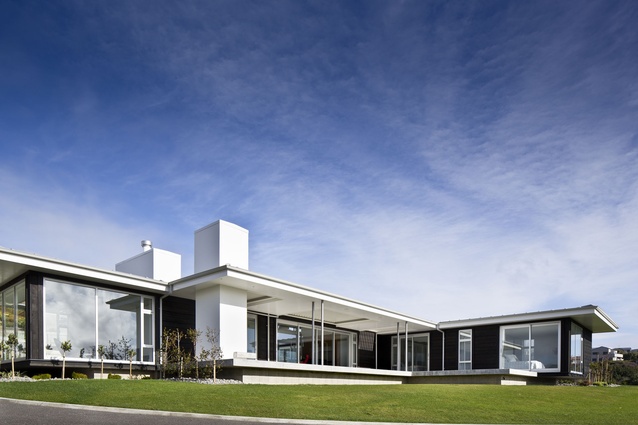Simon Novak and Richard Middleton of Novak+Middleton
Houses talks to Simon Novak and Richard Middleton about working in partnership in the nation’s capital.
Houses: How did you both come to choose architecture as a career?
Simon Novak: In my case, partly through an early childhood experience of going to the 1960s modernist home of Austrian emigré architect Fritz Eisenhofer and thinking it would be pretty cool to be an architect; so probably this and the fact that my mother studied fine arts and my father did engineering, so really perhaps it’s hardly surprising.
Richard Middleton: My story’s a little less glamorous than that. Both my father and a grandfather were dentists and I knew I didn’t want to be a dentist. That said, for as long as I can remember I’ve had an affinity for space and buildings and it was just a natural progression. Architecture was the only option.
Houses: What was the impetus for setting up Novak+Middleton?
RM: We’d been friends from teenagers through sailing but then, as happens, we’d gone our separate ways and then years later we happened to be at the same function or conference and discovered we were both architects. We came up with a concept for working together and initially it started off as three practices running in parallel – Simon’s practice, my practice and then in the middle this third, kind of joint venture business, Novak+Middleton. As time went by, the Novak+Middleton practice got stronger and stronger.
Houses: So, do you each take responsibility for a different aspect of the practice, or do you work collaboratively across all aspects?
SN: We’ve got a pretty strong team approach that allows us to be hands on and involved across the practice, which works well. One of the great things about there being two directors is that as a practice we’re just that much stronger. I think of it as 1 + 1 = 3 or 4 and it’s even more than that. By having a really good talented team of associates and architects and a pretty flat structure everyone has an influence and contribution and knows that what they bring to the table is going to be listened to and appreciated. This has made us pretty sure that this team approach works.
Houses: Is that how you’d characterise the philosophy of Novak+Middleton, that kind of collaborative linear hierarchy?
RM: I think on some level we’ve made the decision to run our practice the way we do and to keep it at a certain size because it does lend itself to the broader philosophy of Novak+Middleton, which is to offer our clients a very personal service and that’s something that’s pretty imperative in the way we approach our architecture, delivering that service.
SN: You know, we really, really enjoy what we do and we want that passion to be shared by our clients. With each job we strive for them, the clients, to be really satisfied with what we’ve created for them and what we’ve created together. Having them involved in the process is really important to how we work and we get tremendous satisfaction in delivering on what’s important to them and their aspirations but at the same time, delivering an outcome that we’re personally satisfied with and something that we’re proud to hang the Novak+Middleton name on
Houses: Some have coined Wellington a difficult city to design in because of its topography. What can architects outside of Wellington learn from Wellington architecture?
RM: That’s an interesting question. I think probably one of Wellington’s biggest strengths is the way that the city centre can’t sprawl due to the topography and so what that does is it tends to bring a focus into the city and creates an intensity, a real vibrancy. There’s something to be gained by understanding that because it brings everybody in together and creates some very interesting spaces and buildings.
SN: In terms of the residential work we get to do, yes there have been some pretty amazing hillside sites, some that are so steep you can’t even walk on them; yet out of those tricky sites with their many constraints usually comes a compelling result. It’s got to be a bespoke design, it’s not going to be the same as the last one you did or the one that’s around the corner, which is what I think we enjoy most about working in Wellington.
Houses: Continuing with the theme then, what’s your favourite Wellington building?
SN: This is a topic Richard and I have discussed before and there are a number of similarities, but we both agreed on the same top two buildings. The first is the Freyberg Pool. It’s stood the test of time really, really well, is incredibly functional, fit for purpose and beautiful. The second is, or was, the Overseas Passenger Terminal on Clyde Quay Pier, which is no longer there. It’s been replaced by the new Clyde Key apartment building by Athfields.
RM: I think the nice thing here is that the original, beautifully designed building, sadly greatly deteriorated over time, has been replaced with a new building that is also extremely good and which, I believe, contributes hugely to Wellington. So while the old one has gone, the new one could well fit into that ‘favourite’ category as well.
Houses: So then, which building in Wellington would you detonate if given the opportunity?
SN: This is another interesting proposition. I guess, for us, we’d detonate some of the greenfield subdivisions of what we would call cookie-cutter houses and we’d take the whole suburb out… without naming any.
RM: Yeah that’s something we struggle to reconcile; row upon row of these houses that are all much of a muchness and contribute not a lot actually to the environment, apart from the fact that people live in them, so yeah they’re pretty disappointing.
The other one would have been the Basin Reserve Flyover, which thankfully has just been given the thumbs down, the commissioners making, what I think is an incredibly important and appropriate decision. Not quite in keeping with the question as it’s kind of detonating an unbuilt building…
SN: Which is probably the best and most sustainable time to get to them.
Houses: Affordability, sustainability, adaptive reuse, zero net energy, these are all concepts that the general public are becoming more concerned with. In your opinion, what is the most important issue facing architecture right now?
SN: Well, they’re all interlinked in some way or other but in terms of our practice, which does a lot of residential work, housing affordability is right up there. It doesn’t matter whether it’s a new house, a holiday house or social or low-cost housing, it’s expensive and getting more and more expensive for a whole raft of reasons. I believe it’s a challenge that we as a profession have to make some inroads into; that is, how can we do things that are smarter in terms of the way we produce these projects. Obviously the design has to be right from the beginning but how can we get the manufacturing costs down and the efficiency up. Prefabrication is one answer and you only have to look around the world, some of the best buildings have been or can be prefabricated and that then leads into sustainability and being more efficient in the kind of materials we use and so on from there.
RM: The other thing that is very frustrating in our industry is that it seems that everything has to get done twice – how many times do you go on site and find that something has to be redone because it’s been done the wrong way or is just not correct. I’m not sure what the answer to that is but ultimately the industry isn’t helping itself and that of course feeds down into the pricing. That’s a real issue for this industry. I think part of it is that we’re still working in the same way that we have done since the beginning of time. It’s very labour intensive and I think that’s a big part of the cost of construction, which is very high in New Zealand, so I think housing affordability or just affordability is a key issue and probably over-arches the others.
SN: And linking into that, adaptive reuse is a very, very important aspect in this area and one that we’re involved in quite a bit. There are a lot of buildings around that are past their best by date but that’s no reason to demolish these buildings and start again. Architects can do really, really clever things with them and in a city like Wellington, particularly as a result of what’s happened in Christchurch, a lot of older buildings are being looked at from a seismic point of view and they do need to be strengthened but that then creates some fantastic opportunities for architects to give these buildings a completely new life. We’ve got a project at the moment that is a beautiful historic church that’s going to be transitioned into five residential apartments. That’s one of the great challenges for architects, how we can deal with some of these historic buildings that are currently threatened as a result of their earthquake status. Creative architects can get right in there and achieve some really nice results that people can really get behind.
Houses: Which of your own projects has had the most impact on you either on a personal level or from a professional level?
RM: We’ve probably got two projects that are I think, I suppose represent the practice really well and are a big part of what we do as a practice. We’re very involved in residential architecture both in the whole broad spectrum of residential so individual homes for individual clients, through to apartment buildings, developer based apartment buildings but selective development based apartment buildings and then through into social housing which is a really interesting part of our practice. As a practice we built up a strong reputation for high end residential architecture and some years ago we got involved in social housing and I vividly remember someone asking why are you doing social housing. You guys do top end residential houses, but you know when you look at it fundamentally there’s actually not a lot of difference in the principle. You know it’s about creating quality of space and light and comfort and security and all those principles are the same regardless of whether we’re designing a multi-million dollar one off house or we’re designing a building that might be used for social housing purpose so it’s just how you wrap it and so it was an interesting transition into the social housing side of things which I think we found not a difficult transition because the principles are so similar.
SN: That’s a hard one to narrow down. We recently won a New Zealand architecture award for the Central Park apartments – a very large 1960s social housing project, which when it was built was the largest block of social housing in New Zealand – and we got the opportunity to rebuild that, which was pretty satisfying. It was nice working on that and we’re currently working on a house in Carterton for a client who has great appreciation for architectural history; so we’re working on what I guess we could say is a Richard Neutra-inspired house that I think is going to be pretty cool.
RM: One of the projects you’re featuring, Te Rama, is one that’s quite special to me personally and one that I think gets pretty close to some of our ideals around the sort of innovation, quality and timelessness of architecture. I think one of the things that I like about Te Rama is that in 50 years’ time I suspect someone will look at it and actually not know when it was designed and built. A sense of timelessness, alongside innovation and quality, is very important in what we do now and I think Central Park and the likes of Te Rama represent those philosophies.
Houses: Do you have any advice for someone who’s starting out that you wish you had received when you were in that position?
RM: I think one of the most important things for anyone starting out is to believe in yourself and to not compromise your fundamental principles. That said, it’s very important to do that with a degree of humility and to be a very good listener. One of the first subjects you study in architecture is about communication – the ability to listen and then the ability to communicate your ideas so that whoever you’re dealing with understands them also.
SN: I call it the three Cs; communication, communication and communication. Don’t stop talking to your clients and to your builders; and listen to them. Also, get as much life experience as you can, travel, look outside architecture, the more you see the better you’ll be. Everything that you take in will make you a better architect.
RM: One parting comment, name the practice with your own name and get your work published, that’s an important one. Funnily enough that was something we were told when we started and I would suggest both of those have been very beneficial to what Novak+Middleton is today.





















